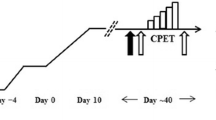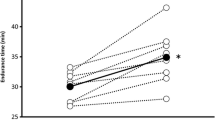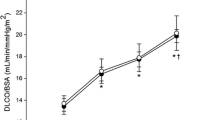Abstract
The purpose of this investigation was to examine if exercise-induced arterial oxyhemoglobin desaturation selectively observed in highly trained endurance athletes could be related to differences in the pulmonary diffusing capacity (D L) measured during exercise. The D L of 24 male endurance athletes was measured using a 3-s breath-hold carbon monoxide procedure (to give D LCO) at rest as well as during cycling at 60% and 90% of these previously determined \({\dot V}\)O2max. Oxyhemoglobin saturation (S aO2%) was monitored throughout both exercise protocols using an Ohmeda Biox II oximeter. Exercise-induced oxyhemoglobin desaturation (DS) (S aO2% < 91% at \({\dot V}\)O2max) was observed in 13 subjects [88.2 (0.6)%] but not in the other 11 nondesaturation subjects [NDS: 92.9 (0.4)%] (P ≤ 0.05), although \({\dot V}\)O2max was not significantly different between the groups [DS: 4.34 (0.65) l / min vs NDS: 4.1 (0.49) l / min]. At rest, no differences in either D LCO [m1 CO · mmHg−1 · min−1: 41.7 (1.7) (DS) vs 41.1 (1.8) (NDS)], D LCO /\({\dot V}\) A [8.2 (0.4) (DS) vs 7.3 (0.9) (NDS)], MVV [l / min: 196.0 (10.4) (DS) vs 182.0 (9.9) (NDS)] or FEV1/FVC [86.3 (2.2) (DS) vs 82.9 (4.7) (NDS)] were found between groups (P ≥ 0.05). However, \({\dot V}\) E /\({\dot V}\)O2 at \({\dot V}\)O2max was lower in the DS group [33.0 (1.1)] compared to the NDS group [36.8 (1.5)] (P ≤ 0.05). Exercise D LCO (m1 CO · mmHg−1 · min−1 ) was not different between groups at either 60% \({\dot V}\)O2max [DS: 55.1 (1.4) vs NDS: 57.2 (2.1)] or at 90% \({\dot V}\)O2max [DS: 61.0 (1.8) vs NDS: 61.4 (2.9)]. A significant relationship (r = 0.698) was calculated to occur between S aO2% and \({\dot V}\) E /\({\dot V}\)O2 during maximal exercise. The present findings indicate that the exercise-induced oxyhemoglobin desaturation seen during submaximal and near-maximal exercise is not related to differences in D L, although during maximal exercise S aO2 may be limited by a relatively lower exercise ventilation.
Similar content being viewed by others
Author information
Authors and Affiliations
Additional information
Accepted: 25 September 1996
Rights and permissions
About this article
Cite this article
Turcotte, R., Kiteala, L., Marcotte, J. et al. Exercise-induced oxyhemoglobin desaturation and pulmonary diffusing capacity during high-intensity exercise. Eur J Appl Physiol 75, 425–430 (1997). https://doi.org/10.1007/s004210050183
Issue Date:
DOI: https://doi.org/10.1007/s004210050183




